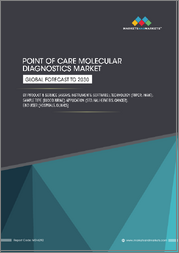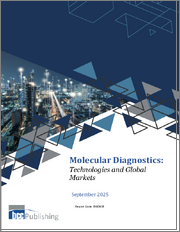
|
시장보고서
상품코드
1697459
분자 종양 진단 시장 - 세계 및 지역별 분석 : 제품별, 기술별, 용도별, 암 유형별, 최종사용자별, 국가별 - 분석과 예측(2024년-2033년)Molecular Oncology Diagnostics Market - A Global and Regional Analysis: Focus on Product, Technology, Application, Cancer Type, End User, and Country - Analysis and Forecast, 2024-2033 |
||||||
세계 분자 종양 진단 시장 규모는 2024년 24억 1,090만 달러에 달했습니다.
이 시장은 11.06%의 연평균 복합 성장률(CAGR)로 성장하여 2033년에는 61억 9,510만 달러에 달할 것으로 예측됩니다. 세계 분자 종양 진단 시장의 성장은 차세대 염기서열 분석, 디지털 PCR, 액체 생검 등 분자진단 분야의 기술 발전과 전 세계 암 유병률 증가에 의해 주도될 것으로 예상됩니다. 그러나 세계 분자 종양 진단 시장의 성장은 몇 가지 과제에 의해 저해되고 있습니다. 특히, 의료 재정이 제한적인 중저소득 국가에서는 분자진단 검사의 높은 비용이 여전히 큰 장벽으로 작용하고 있습니다. 또한, 이러한 첨단 진단 도구를 효과적으로 사용할 수 있도록 훈련된 숙련된 전문가가 부족하여 성장을 더욱 저해하고 있습니다.
이러한 도전에도 불구하고, 세계 분자 종양 진단 시장은 끊임없는 기술 발전에 힘입어 지속적으로 성장하고 있습니다. 생명공학 기업, 제약사, 학술 기관의 전략적 제휴는 혁신을 촉진하고 새로운 진단 기술의 개발 및 채택을 가속화하기 위해 필수적입니다. 전 세계 암 치료를 개선하는 데 있어 분자진단의 잠재력을 극대화하기 위해서는 비용과 인력 개발의 장애물을 극복하는 것이 중요합니다.
| 주요 시장 통계 | |
|---|---|
| 예측 기간 | 2024-2033년 |
| 2024년 평가 | 24억 1,000만 달러 |
| 2033년 예측 | 61억 9,000만 달러 |
| CAGR | 11.06% |
세계 분자 종양 진단 시장은 발전 단계에 있습니다. 분자 종양 진단 생태계는 혁신적인 제품 출시와 규제 당국의 승인 획득이 급증하면서 암 치료의 획기적인 발전을 주도하고 있습니다. 기업들은 차세대 염기서열 분석(NGS), 액체 생검, 디지털 PCR과 같은 첨단 기술을 활용한 새로운 진단 도구를 지속적으로 개발하여 암의 검출 및 모니터링의 정확성과 효율성을 높이고 있습니다. 이러한 기술 혁신은 개인화된 치료 계획을 제공하고 환자의 예후를 개선하는 데 있어 매우 중요합니다.
향후 몇 년동안 세계 분자 종양 진단 시장의 성장은 주로 모든 유형의 암의 유병률 증가에 기인할 것으로 예상됩니다. 고령화, 좌식 생활습관, 유전적 위험요인 등의 요인으로 인해 전 세계 암 발병률은 지속적으로 증가하고 있으며, 2022년에는 전 세계적으로 약 2,000만 명의 암 환자가 새로 발생하고 970만 명이 암으로 인해 사망할 것으로 예상됩니다. 폐암이 12.40%로 가장 많고, 유방암이 11.60%로 그 뒤를 잇고 있습니다. 암 발병률 증가와 조기 발견의 중요성 증가는 예측 기간 동안 분자 종양 진단 시장의 성장을 가속할 것으로 예상됩니다.
제품별로는 키트 및 분석은 정기적인 수요와 저렴한 비용으로 인해 세계 분자 종양 진단 시장은 제품 부문이 주도할 것으로 예상됩니다.
기술별로는 고감도, 높은 정확도, 높은 비용 효율성으로 인해 세계 분자 종양 진단 시장은 중합효소 연쇄반응(PCR) 분야가 독점하고 있습니다.
용도별로는 임상 진단이 세계 분자 종양 진단 시장을 주도하고 있습니다. 이러한 우위는 의료 분야에서 정밀의료의 채택이 증가함에 따라 분자진단은 표적 치료 결정을 유도하기 위해 특정 암 유발 돌연변이를 식별하는 데 필수적인 역할을 하고 있습니다.
암종별로는 고형암이 전 세계 분자종양학 진단 시장을 독점하고 있습니다. 이러한 우위는 혈액암에 비해 유방암, 폐암, 대장암 등 고형암의 유병률이 높기 때문입니다. 고형암은 가장 흔한 암 중 하나이며, 효과적인 치료 계획을 세우기 위해서는 광범위한 진단 검사가 필요하기 때문에 이 분야의 분자진단 약품에 대한 수요가 증가하고 있습니다.
최종 사용자별로 보면, 세계 분자 종양 진단 의약품 시장은 병원 부문이 독점하고 있습니다. 이는 주로 병원이 환자를 직접 치료하는 곳이며, 신속하고 정확한 진단 검사가 암 치료에서 적시에 의사결정을 내리는 데 필수적이기 때문입니다.
북미는 2023년 9억 6,960만 달러의 매출을 기록할 것으로 예상됩니다. 북미 분자 종양 진단 시장은 몇 가지 중요한 요인으로 인해 크게 성장할 것으로 예상되며, 2050년까지 고형암과 혈액 악성 종양 모두 크게 증가할 것이라는 예측도 있습니다. 또한, 이 지역은 세계 기업과 현지 기업 모두 강력한 존재감을 보이고 있으며, 첨단 진단 기술에 대한 접근성이 향상되고 있습니다.
세계의 분자 종양 진단 시장에 대해 조사했으며, 시장 개요와 함께 제품별/기술별/용도별/암 유형별/최종사용자별/국가별 동향, 시장 진출기업 프로파일 등의 정보를 전해드립니다.
목차
주요 요약
제1장 세계의 분자 종양 진단 시장 : 업계 전망
- 세계의 암 발생률과 유병률(암 유형별)
- 북미
- 유럽
- 아시아태평양
- 기타 지역
- 동향 : 현황과 향후에 대한 영향 평가
- 참여 기업간 파트너십 강화
- 분자 종양 진단 에코시스템 혁신적인 제품 발매와 규제 승인 증가
- 규제 상황
- COVID-19의 분자 종양 진단 시장에 대한 영향
- 액체생검에 근거한 분자진단
- 임상 검사(LDT) 및 체외진단(IVD)
- 분자 종양 진단 시장에서 동반진단의 역할
- 시장 역학
- 시장 성장 촉진요인
- 시장이 해결해야 할 과제
- 시장 기회
제2장 세계의 분자 종양 진단 시장(제품별)
- 제품 요약
- 키트 및 어세이
- 기기
- 소프트웨어
제3장 세계의 분자 종양 진단 시장(기술별)
- 기술 요약
- 중합효소 연쇄반응
- 차세대 시퀀싱
- 면역조직화학
- Fluorescence In-Situ Hybridization
- 유세포분석기
- 기타
제4장 세계의 분자 종양 진단 시장(용도별)
- 애플리케이션 요약
- 임상 진단
- 연구 사용
제5장 세계의 분자 종양 진단 시장(암 유형별)
- 암 유형 요약
- 고형 종양
- 유방암
- 폐암
- 대장암
- 전립선암
- 난소암
- 기타
- 조혈 악성 종양
- 림프종
- 백혈병
- 다발성 골수종
- 기타
제6장 세계의 분자 종양 진단 시장(최종사용자별)
- 최종사용자 요약
- 병원 및 진단센터
- 표준검사실
- 제약회사 및 바이오테크놀러지 기업
- 학술연구기관
제7장 세계의 분자 종양 진단 시장(지역별)
- 지역 요약
- 성장 촉진요인과 억제요인
- 북미
- 유럽
- 아시아태평양
- 기타 지역
제8장 세계의 분자 종양 진단 시장 - 경쟁 벤치마킹과 기업 개요
- 주요 전략 개발
- 기업 점유율 분석
- 기업 개요
- Abbott Laboratories
- Agilent Technologies, Inc.
- Biocartis Group NV
- bioMerieux
- Bio-Rad Laboratories, Inc.
- Danaher Corporation
- Exact Sciences Corporation
- F. Hoffmann-La Roche Ltd.
- Guardant Health, Inc.
- Hologic, Inc.
- Illumina, Inc.
- Invivoscribe, Inc.
- Myriad Genetics, Inc.
- QIAGEN N.V.
- Sysmex Corporation
- Thermo Fisher Scientific, Inc.
제9장 조사 방법
LSH 25.04.16Global Molecular Oncology Diagnostics Industry Overview:
The global molecular oncology diagnostics market was valued at $2,410.9 million in 2024, and the market is expected to grow with a CAGR of 11.06% and reach $6,195.1 million by 2033. The growth in the global molecular oncology diagnostics market is expected to be driven by rising technological advancements in molecular diagnostics such as next-generation sequencing, digital PCR, and liquid biopsy, among others and the rising prevalence of cancers globally. However, the expansion of the global molecular oncology diagnostics market has been hindered by several challenges. The high cost of molecular diagnostic tests remains a major barrier, particularly in low- and middle-income countries where healthcare funding is often limited. Additionally, there has been a noticeable gap in the availability of skilled professionals who are trained to use these advanced diagnostic tools effectively, further restraining the growth.
Despite these challenges, the global molecular oncology diagnostics market continues to grow, driven by continuous technological advancements. Strategic collaborations between biotechnology companies, pharmaceutical firms, and academic institutions are vital, fostering innovation and accelerating the development and adoption of new diagnostic technologies. Overcoming the hurdles of cost and workforce training will be crucial for maximizing the potential of molecular diagnostics in improving cancer care globally.
| KEY MARKET STATISTICS | |
|---|---|
| Forecast Period | 2024 - 2033 |
| 2024 Evaluation | $2.41 Billion |
| 2033 Forecast | $6.19 Billion |
| CAGR | 11.06% |
Market Lifecycle Stage
The global molecular oncology diagnostics market is in progressive phase. The molecular oncology diagnostics ecosystem is witnessing a surge in the launch of innovative products and obtaining regulatory approvals, driving significant advancements in cancer care. Companies are continuously developing new diagnostic tools that leverage cutting-edge technologies such as next-generation sequencing (NGS), liquid biopsy, and digital PCR, which enhance the accuracy and efficiency of cancer detection and monitoring. These innovations are crucial in providing personalized treatment plans and improving patient outcomes.
Impact
The expansion of the global molecular oncology diagnostics market in the coming years will be primarily driven by the rising prevalence of cancer across all types. The global incidence of cancer continues to increase due to factors such as an aging population, sedentary lifestyles, and hereditary risk factors. In 2022, there were approximately 20 million new cancer cases and 9.7 million cancer-related deaths worldwide. Lung cancer accounted for the highest share of total cancer cases at 12.40%, followed by breast cancer at 11.60%. The growing burden of cancer and the increasing emphasis on early detection are expected to propel the growth of the molecular oncology diagnostics market over the forecast period.
Market Segmentation:
Segmentation 1: by Product
- Kits and Assays
- Instruments
- Software
Based on product, the kits and assays in the global molecular oncology diagnostics market is expected to dominate by product segment owing to their recurring demand and lower cost.
Segmentation 2: by Technology
- Polymerase Chain Reaction
- Next-Generation Sequencing
- Immunohistochemistry
- Fluorescence In-Situ Hybridization
- Flow Cytometry
- Other Technologies
On the basis of technology, the global molecular oncology diagnostics market is dominated by the polymerase chain reaction segment due to its high sensitivity, accuracy, and cost-effectiveness.
Segmentation 3: by Application
- Clinical Diagnostics
- Research Use
Based on application, the global molecular oncology diagnostics market is dominated by the clinical diagnostics. This predominance has been driven by the increasing adoption of precision medicine in healthcare, where molecular diagnostics are integral for identifying specific oncogenic mutations to guide targeted therapy decisions.
Segmentation 4: by Cancer Type
- Solid Tumors
- Hematologic Malignancies
Based on cancer type, the global molecular oncology diagnostics market is dominated by the solid tumors. This predominance can be attributed to the higher prevalence of solid tumors, such as breast, lung, and colorectal cancers, compared to hematological malignancies. Solid tumors represent a broad array of the most common cancers, which necessitates extensive diagnostic testing for effective treatment planning, thus driving higher demand for molecular diagnostics within this segment.
Segmentation 5: by End User
- Hospitals and Diagnostic Centers
- Reference Laboratories
- Pharmaceutical and Biotechnology Companies
- Academic and Research Institutes
Based on end user, the global molecular oncology diagnostics market is dominated by the hospitals segment. This is primarily due to hospitals' direct patient care setting, where rapid and accurate diagnostic testing is crucial for timely decision-making in cancer treatment.
Segmentation 6: by Region
- North America - U.S., and Canada
- Europe - U.K., Germany, France, Italy, Spain, and Rest-of-Europe
- Asia-Pacific - Japan, China, India, South Korea, Australia, and Rest-of-Asia-Pacific
- Rest-of-the-World
North America generated the highest revenue of $969.6 million in 2023. The molecular oncology diagnostics market in North America is poised for significant growth driven by several key factors. The increasing incidence of cancer across the region is a major driver, with projections indicating a substantial rise in both solid tumors and hematological malignancies by 2050. Moreover, the region benefits from the strong presence of both global and local players, enhancing accessibility to advanced diagnostic technologies.
Recent Developments in the Global Molecular Oncology Diagnostics Market
- In May 2024, Becton, Dickinson and Company announced that the U.S. Food and Drug Administration (FDA) has approved the use of self-collected vaginal specimens for human papillomavirus (HPV) testing, to be utilized when cervical specimens are not available.
- In February 2024, Myriad Genetics, Inc. announced a research collaboration with the National Cancer Center Hospital East (NCCHE) in Japan to investigate the prognostic and predictive value of molecular residual disease (MRD) testing. The SCRUM-MONSTAR-SCREEN-3 study will utilize Myriad's ultra-sensitive MRD test, Precise MRD, to monitor circulating tumor DNA (ctDNA) over time in patients with various solid tumors and hematological cancers.
- In January 2024, Guardant Health and Hikma have partnered to provide cancer screening and comprehensive genomic profiling tests in the Middle East and North Africa.
- In November 2023, Illumina launched an advanced liquid biopsy assay designed to enable comprehensive genomic profiling of solid tumors.
Demand - Drivers and Limitations
The following are the demand drivers for the global molecular oncology diagnostics market:
- Rising Incidence of Cancer Cases
- Rising Technological Advancements in Molecular Diagnostics
- Growth in Biomarker Identification and Transformation in Molecular Techniques
- Growing Demand for Personalized Medicine
The market is expected to face some limitations due to the following challenges:
- Lack of Qualified Professionals
- High Cost of Molecular Diagnostic Kits and Assays Hindering the Adoption Rate
Key Market Players and Competition Synopsis
The global molecular oncology diagnostics market is expected to witness significant growth, fueled by the increasing incidence of cancer worldwide and the rising demand for personalized medicine. This sector is revolutionizing cancer treatment by enabling precise tumor profiling through advanced technologies such as next-generation sequencing (NGS). These innovations allow for the early detection of cancers and the identification of specific genetic mutations, facilitating tailored therapeutic strategies that enhance treatment efficacy and patient outcomes.
Some of the prominent key players in this market are:
- Abbott Laboratories
- Agilent Technologies, Inc.
- Abbott Laboratories
- Agilent Technologies, Inc.
- Biocartis Group NV
- bioMerieux
- Bio-Rad Laboratories, Inc.
- Danaher Corporation
- Exact Sciences Corporation
- F. Hoffmann-La Roche Ltd
- Guardant Health, Inc.
- Hologic, Inc.
- Illumina, Inc.
- Invivoscribe, Inc.
- Myriad Genetics, Inc.
- QIAGEN N.V.
- Sysmex Corporation
- Thermo Fisher Scientific, Inc.
Companies that are not a part of the aforementioned pool have been well represented across different sections of the report (wherever applicable).
Table of Contents
Executive Summary
Scope and Definition
1 Global Molecular Oncology Diagnostics Market: Industry Outlook
- 1.1 Global Incidence and Prevalence of Cancer (by Cancer Type)
- 1.1.1 North America
- 1.1.2 Europe
- 1.1.3 Asia-Pacific
- 1.1.4 Rest-of-the-World
- 1.2 Trends: Current and Future Impact Assessment
- 1.2.1 Increasing Partnerships among Players
- 1.2.2 Increasing Launch of Innovative Products and Regulatory Approvals in Molecular Oncology Diagnostics Ecosystem
- 1.3 Regulatory Landscape
- 1.3.1 Legal Requirements and Framework in the U.S.
- 1.3.1.1 FDA Regulation
- 1.3.1.2 CMS Regulation (Reimbursement Scenario)
- 1.3.2 Legal Requirements and Framework in Europe
- 1.3.3 Legal Requirements and Framework in Asia-Pacific
- 1.3.3.1 China
- 1.3.3.2 Japan
- 1.3.1 Legal Requirements and Framework in the U.S.
- 1.4 Impact of COVID-19 on the Molecular Oncology Diagnostics Market
- 1.5 Liquid Biopsy-Based Cancer Molecular Diagnostics
- 1.6 Laboratory-Developed Test (LDT) vs. In-Vitro Diagnostics (IVD)
- 1.7 Role of Companion Diagnostics in the Molecular Oncology Diagnostics Market
- 1.8 Market Dynamics
- 1.8.1 Market Drivers
- 1.8.1.1 Rising Incidence of Cancer Cases
- 1.8.1.2 Rising Technological Advancements in Molecular Diagnostics
- 1.8.1.3 Growth in Biomarker Identification and Transformations in Molecular Techniques
- 1.8.1.4 Growing Demand for Personalized Medicine
- 1.8.2 Market Challenges
- 1.8.2.1 Lack of Qualified Professionals
- 1.8.2.2 High Cost of Molecular Diagnostic Kits and Assays Hindering the Adoption Rate
- 1.8.3 Market Opportunities
- 1.8.3.1 Focus on Reimbursement and Medical Coverage for Molecular Oncology Diagnostics
- 1.8.3.2 Focus on Next-Generation Ultrasensitive Molecular Diagnostics
- 1.8.3.3 Increasing Growth Opportunities for Molecular Diagnostics Companies in Emerging Economies
- 1.8.1 Market Drivers
2 Global Molecular Oncology Diagnostics Market (by Product)
- 2.1 Product Summary
- 2.2 Kits and Assays
- 2.3 Instruments
- 2.4 Software
3 Global Molecular Oncology Diagnostics Market (by Technology)
- 3.1 Technology Summary
- 3.2 Polymerase Chain Reaction
- 3.3 Next-Generation Sequencing
- 3.4 Immunohistochemistry
- 3.5 Fluorescence In-Situ Hybridization
- 3.6 Flow Cytometry
- 3.7 Other Technologies
4 Global Molecular Oncology Diagnostics Market (by Application)
- 4.1 Application Summary
- 4.2 Clinical Diagnostics
- 4.3 Research Use
5 Global Molecular Oncology Diagnostics Market (by Cancer Type)
- 5.1 Cancer Type Summary
- 5.2 Solid Tumors
- 5.2.1 Breast Cancer
- 5.2.2 Lung Cancer
- 5.2.3 Colorectal Cancer
- 5.2.4 Prostate Cancer
- 5.2.5 Ovarian Cancer
- 5.2.6 Other Solid Tumors
- 5.3 Hematological Malignancies
- 5.3.1 Lymphoma
- 5.3.2 Leukemia
- 5.3.3 Multiple Myeloma
- 5.3.4 Other Hematological Malignancies
6 Global Molecular Oncology Diagnostic Market (by End User)
- 6.1 End User Summary
- 6.2 Hospitals and Diagnostic Centers
- 6.3 Reference Laboratories
- 6.4 Pharmaceutical and Biotechnology Companies
- 6.5 Academic and Research Institutes
7 Global Molecular Oncology Diagnostics Market: by Region
- 7.1 Regional Summary
- 7.2 Drivers and Restraints
- 7.3 North America
- 7.3.1 Regional Overview
- 7.3.2 Driving Factors for Market Growth
- 7.3.3 Factors Challenging the Market
- 7.3.4 By Cancer Type
- 7.3.5 By End User
- 7.3.6 U.S.
- 7.3.6.1 By Cancer Type
- 7.3.6.2 By End User
- 7.3.7 Canada
- 7.3.7.1 By Cancer Type
- 7.3.7.2 By End User
- 7.4 Europe
- 7.4.1 Regional Overview
- 7.4.2 Driving Factors for Market Growth
- 7.4.3 Factors Challenging the Market
- 7.4.4 By Cancer Type
- 7.4.5 By End User
- 7.4.6 Germany
- 7.4.6.1 By Cancer Type
- 7.4.6.2 By End User
- 7.4.7 France
- 7.4.7.1 By Cancer Type
- 7.4.7.2 By End User
- 7.4.8 U.K.
- 7.4.8.1 By Cancer Type
- 7.4.8.2 By End User
- 7.4.9 Italy
- 7.4.9.1 By Cancer Type
- 7.4.9.2 By End User
- 7.4.10 Spain
- 7.4.10.1 By Cancer Type
- 7.4.10.2 By End User
- 7.4.11 Rest-of-Europe
- 7.4.11.1 By Cancer Type
- 7.4.11.2 By End User
- 7.5 Asia-Pacific
- 7.5.1 Regional Overview
- 7.5.2 Driving Factors for Market Growth
- 7.5.3 Factors Challenging the Market
- 7.5.4 By Cancer Type
- 7.5.5 By End User
- 7.5.6 China
- 7.5.6.1 By Cancer Type
- 7.5.6.2 By End User
- 7.5.7 India
- 7.5.7.1 By Cancer Type
- 7.5.7.2 By End User
- 7.5.8 Japan
- 7.5.8.1 By Cancer Type
- 7.5.8.2 By End User
- 7.5.9 South Korea
- 7.5.9.1 By Cancer Type
- 7.5.9.2 By End User
- 7.5.10 Australia
- 7.5.10.1 By Cancer Type
- 7.5.10.2 By End User
- 7.5.11 Rest-of-Asia-Pacific
- 7.5.11.1 By Cancer Type
- 7.5.11.2 By End User
- 7.6 Rest-of-the-World
- 7.6.1 Regional Overview
- 7.6.2 Driving Factors for Market Growth
- 7.6.3 Factors Challenging the Market
- 7.6.4 By Cancer Type
- 7.6.5 By End User
8 Global Molecular Oncology Diagnostics Market - Competitive Benchmarking & Company Profiles
- 8.1 Key Strategic Development
- 8.1.1 Partnerships, Alliances, and Business Expansions
- 8.1.2 New Offerings
- 8.1.3 Mergers and Acquisitions
- 8.1.4 Regulatory and Legal Activities
- 8.2 Company Share Analysis
- 8.3 Company Profiles
- 8.3.1 Abbott Laboratories
- 8.3.1.1 Overview
- 8.3.1.2 Top Products
- 8.3.1.3 Top Competitors
- 8.3.1.4 Target Customers/End User
- 8.3.1.5 Key Personnel
- 8.3.1.6 Corporate Strategies
- 8.3.1.7 Analyst View
- 8.3.2 Agilent Technologies, Inc.
- 8.3.2.1 Overview
- 8.3.2.2 Top Products/Product Portfolio
- 8.3.2.3 Top Competitors
- 8.3.2.4 Target Customers/End User
- 8.3.2.5 Key Personnel
- 8.3.2.6 Analyst View
- 8.3.3 Biocartis Group NV
- 8.3.3.1 Overview
- 8.3.3.2 Top Products
- 8.3.3.3 Top Competitors
- 8.3.3.4 Target Customers/End User
- 8.3.3.5 Key Personnel
- 8.3.3.6 Analyst View
- 8.3.4 bioMerieux
- 8.3.4.1 Overview
- 8.3.4.2 Top Products
- 8.3.4.3 Top Competitors
- 8.3.4.4 Target Customers/End User
- 8.3.4.5 Key Personnel
- 8.3.4.6 Analyst View
- 8.3.5 Bio-Rad Laboratories, Inc.
- 8.3.5.1 Overview
- 8.3.5.2 Top Products
- 8.3.5.3 Top Competitors
- 8.3.5.4 Target Customers/End User
- 8.3.5.5 Key Personnel
- 8.3.5.6 Analyst View
- 8.3.6 Danaher Corporation
- 8.3.6.1 Overview
- 8.3.6.2 Top Products/Product Portfolio
- 8.3.6.3 Top Competitors
- 8.3.6.4 Target Customers/End User
- 8.3.6.5 Key Personnel
- 8.3.6.6 Analyst View
- 8.3.7 Exact Sciences Corporation
- 8.3.7.1 Overview
- 8.3.7.2 Top Products/Product Portfolio
- 8.3.7.3 Top Competitors
- 8.3.7.4 Target Customers/End User
- 8.3.7.5 Key Personnel
- 8.3.7.6 Analyst View
- 8.3.8 F. Hoffmann-La Roche Ltd.
- 8.3.8.1 Overview
- 8.3.8.2 Top Products
- 8.3.8.3 Top Competitors
- 8.3.8.4 Target Customers/End User
- 8.3.8.5 Key Personnel
- 8.3.8.6 Analyst View
- 8.3.9 Guardant Health, Inc.
- 8.3.9.1 Overview
- 8.3.9.2 Top Products
- 8.3.9.3 Top Competitors
- 8.3.9.4 Target Customers/End User
- 8.3.9.5 Key Personnel
- 8.3.9.6 Analyst View
- 8.3.10 Hologic, Inc.
- 8.3.10.1 Overview
- 8.3.10.2 Top Products
- 8.3.10.3 Top Competitors
- 8.3.10.4 Target Customers/End User
- 8.3.10.5 Key Personnel
- 8.3.10.6 Analyst View
- 8.3.11 Illumina, Inc.
- 8.3.11.1 Overview
- 8.3.11.2 Top Products
- 8.3.11.3 Top Competitors
- 8.3.11.4 Target Customers/End User
- 8.3.11.5 Key Personnel
- 8.3.11.6 Analyst View
- 8.3.12 Invivoscribe, Inc.
- 8.3.12.1 Overview
- 8.3.12.2 Top Products
- 8.3.12.3 Target Competitors
- 8.3.12.4 Target Customers/End User
- 8.3.12.5 Key Personnel
- 8.3.12.6 Analyst View
- 8.3.13 Myriad Genetics, Inc.
- 8.3.13.1 Overview
- 8.3.13.2 Top Products
- 8.3.13.3 Top Competitors
- 8.3.13.4 Target Customers/End User
- 8.3.13.5 Key Personnel
- 8.3.13.6 Analyst View
- 8.3.14 QIAGEN N.V.
- 8.3.14.1 Overview
- 8.3.14.2 Top Products
- 8.3.14.3 Top Competitors
- 8.3.14.4 Target Customers/End User
- 8.3.14.5 Key Personnel
- 8.3.14.6 Analyst View
- 8.3.15 Sysmex Corporation
- 8.3.15.1 Overview
- 8.3.15.2 Top Products
- 8.3.15.3 Top Competitors
- 8.3.15.4 Target Customers/End User
- 8.3.15.5 Key Personnel
- 8.3.15.6 Analyst View
- 8.3.16 Thermo Fisher Scientific, Inc.
- 8.3.16.1 Overview
- 8.3.16.2 Top Products
- 8.3.16.3 Top Competitors
- 8.3.16.4 Target Customers/End User
- 8.3.16.5 Key Personnel
- 8.3.16.6 Analyst View
- 8.3.1 Abbott Laboratories
9 Research Methodology
- 9.1 Data Sources
- 9.1.1 Primary Data Sources
- 9.1.2 Secondary Data Sources
- 9.1.3 Data Triangulation
- 9.2 Market Estimation and Forecast



















